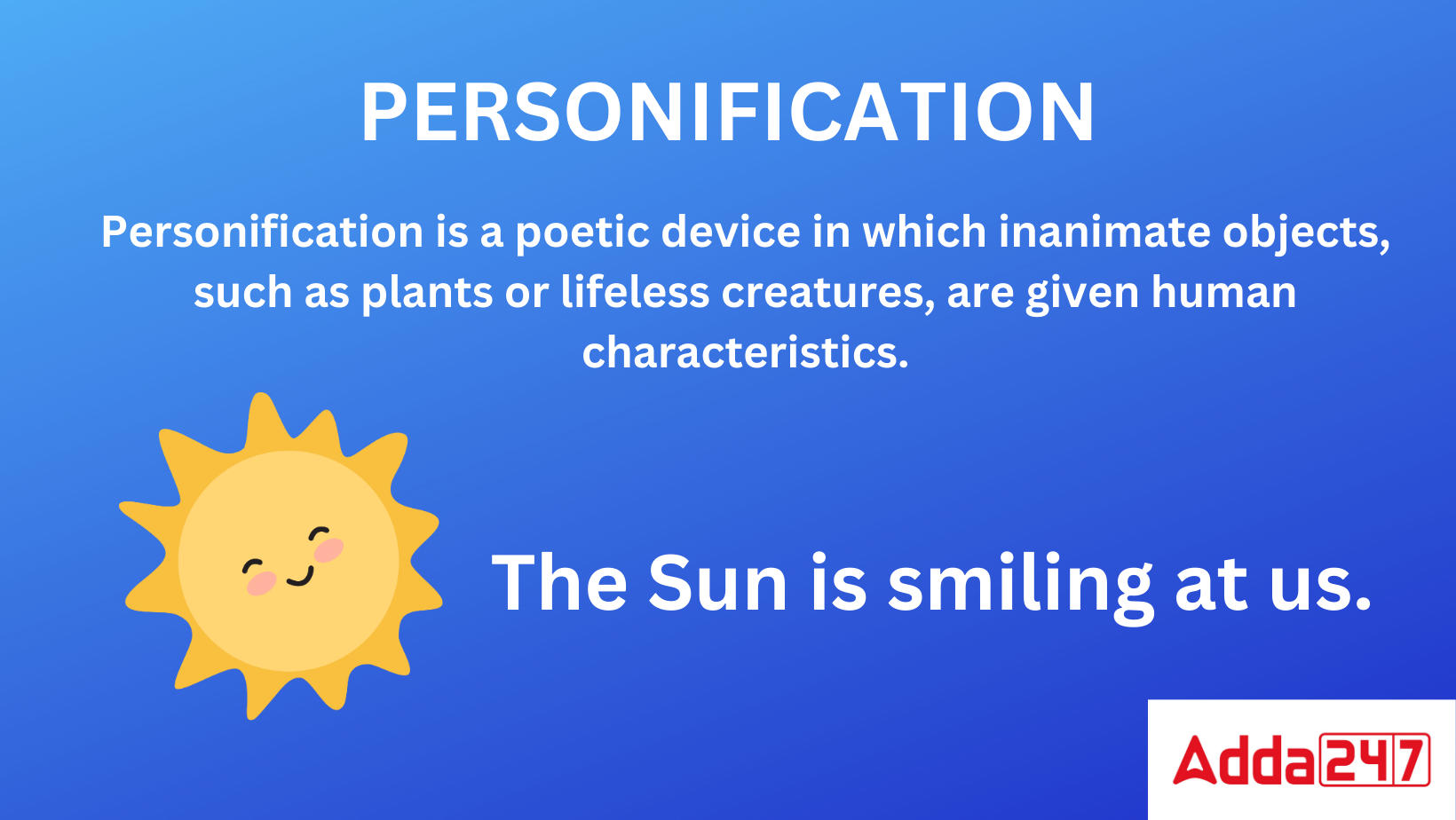Table of Contents
Personification
Personification is a figure of speech in which a thing, idea, or expression is given human characteristics and/or emotions, or is discussed as if it were a person. Personification is a popular type of metaphor in which non-human objects are given human traits. By giving them recognized human behaviours and emotions, writers can give inanimate things, animals, and even abstract ideas of life and motion.
Personification Meaning
Personification is a figure of speech used to give qualities of people to things that are not people. It can also be utilised to provide a human face to an intangible feature.
Personification Definition
Personification is described as “the practise of representing objects, characteristics, etc. as persons, in art and literature; an item, quality, etc. that is portrayed in this way,” in the Oxford Learner’s Dictionary. Personification is described as “the act of providing a human attribute or characteristic to something which is not human” by the Cambridge Dictionary.
Personification is described as “representing a thing or abstraction as a person or as the human form” in the Merriam-Webster Dictionary. Personification is defined by the Collins Dictionary as “the depiction of an abstract quality or idea in the shape of a person, creature, etc., as in art and literature” and “the attribution of human traits to things, abstract ideas, etc., as for literary or artistic effect.”
Personification Poetic Device
Personification is a poetic device in which inanimate objects, such as plants or lifeless creatures, are given human characteristics. This creates a poem that is rich in imagery and description. I noticed a young, lonely boy, as stated in the first stanza of Jackie Kay’s poem Way Down down in the Streets of Paris.
Personification Figure of Speech
Personification figure of speech shows attributing human traits to inanimate objects. It is employed to imply that something has done something when, in actuality, it has not. This kind of figurative language is employed as a literary strategy to enhance the vividness and descriptiveness of a piece of writing. Additionally, it is employed to help the reader comprehend the content and can enhance the originality and distinctiveness of a piece of writing.
How to use Personification in a sentence?
Personification can be used in a sentence to provide a succinct description of something as well as to give the object or virtue being personified a deeper significance and connection. It cannot, however, be utilised in formal essays, any professional or technical writing, or to communicate literal meaning because it is figurative.
Ensure that your sentence makes sense before using personification. Personification must only be used when necessary, just like every other figure of speech. Personification can be utilised in writing to help readers identify with both human and non-human characters. Using the appropriate verbs to express what you want to say is the only thing you need to be careful about.
Personification Definition and Examples
Personification definition is the practise of representing objects, characteristics, etc. as persons, in art and literature; an item, quality, etc. that is portrayed in this way, Personification Examples: You’re likely to come across or employ personification in everyday language frequently. It is a frequent figure of speech that is quite well-liked. Now let’s look at some real-world uses of personification examples in sentences from various contexts.
- The book provides the information that we need to understand the language.
- The car was suffering and needed some attention.
- The stars were dancing playfully in the sky.
- The tattered house appeared to be distressed.
- The red car raced by, screaming for someone to notice its speed.
- The bread jumped out of the toaster.
- He was aware that opportunity had come knocking at his door.
- The popcorn jumped around the microwave.
- She did not see that her last chance was about to walk out of the door.
- The new record from Elton John flew off the shelves.
- The wind howled through the forest.
- I fell over because the kerb jumped out before me.
- The news took me by surprise when I heard it.
- Before I knew it, it was midnight, time had crept up on me.
- The hurricane attacked the city leaving it in ruins.
- My life passed me by.
- The sun glared down from the sky on that hot summer’s day.
- The evil tree lurked in the shadowy woodland.
- When I lost my job, my life screeched to a halt.
- The waves lashed out at the ocean, causing the boat to falter.
- My alarm clock loves to disturb me every morning.
Personification Examples in English
Personification is a literary technique that is probably used frequently. This could take the shape of poetry, music, or a play. We’ll look at several instances of personification in written language in the examples that follow.
- In the poem ‘Two sunflowers move in to the yellow room’ written by Nancy Willard, we see an example of personification many times, one example of this is the line “Oh Will we are tired of the weather, said the sunflowers as they shone with dew.”
- In William Wordsworth’s poem ‘Daffodils’ we again see many examples of personification, one of these is in the opening line of ‘I wandered lonely as a cloud.’
- In the play Romeo and Juliet written by William Shakespeare, we can see an example of personification in a line delivered by Friar Tuck, which reads ‘the grey-eyed morning smiles at the nights which frowns.’
- In ‘The green gables letter’ written by L G Montgomery we see personification being used in the sentence ‘the woods are preparing to go to sleep.’
- In another scene from the play Romeo and Juliet written by William Shakespeare, we see an example of personification in the line ‘when well dressed April comes on the heel of winter.’
- In ‘Have you got a little brook in your heart’ written by Emily Dickinson, we can see another example of personification in the line ‘where the bashful flowers blew.’
- In another piece of writing written by William Shakespeare called ‘How Pearl Button was kidnapped, we see an example of personification in use in the following line; ‘It was afternoon time of a sunny day in which the winds played hide and seek.’
- In the poem, ‘The waste land’ written by T S Elliot we see personification being used in the opening line, which reads ‘April is the most cruel month.’
- In another piece written by Emily Dickinson, entitled Because I could not stop for death, we see personification being used in the line ‘Because I couldn’t stop for death, he then stopped for me.’
Personification in Hindi
व्यक्तित्व भाषण का एक अलंकार है जिसमें एक चीज, विचार या अभिव्यक्ति को मानवीय विशेषताओं और/या भावनाओं को दिया जाता है, या इस पर चर्चा की जाती है जैसे कि यह एक व्यक्ति हो। निजीकरण एक लोकप्रिय प्रकार का रूपक है जिसमें गैर-मानव वस्तुओं को मानवीय लक्षण दिए जाते हैं। उन्हें मान्यता प्राप्त मानव व्यवहार और भावनाओं को देकर, लेखक निर्जीव वस्तुओं, जानवरों और यहाँ तक कि जीवन और गति के अमूर्त विचारों को भी दे सकते हैं।
Definition of Personification in Hindi
निजीकरण भाषण का एक अलंकार है जिसका उपयोग लोगों को उन चीजों के गुण देने के लिए किया जाता है जो लोग नहीं हैं। इसका उपयोग अमूर्त विशेषता को मानवीय चेहरा प्रदान करने के लिए भी किया जा सकता है।
ऑक्सफ़ोर्ड लर्नर्स डिक्शनरी में व्यक्तित्व को “कला और साहित्य में व्यक्तियों के रूप में वस्तुओं, विशेषताओं आदि का प्रतिनिधित्व करने का अभ्यास; एक वस्तु, गुणवत्ता, आदि जो इस तरह से चित्रित किया गया है” के रूप में वर्णित किया गया है। कैंब्रिज डिक्शनरी द्वारा निजीकरण को “मानव गुण या किसी ऐसी चीज़ की विशेषता प्रदान करने का कार्य” के रूप में वर्णित किया गया है जो मानव नहीं है।
मेरियम-वेबस्टर डिक्शनरी में व्यक्तित्व को “एक व्यक्ति या मानव रूप के रूप में एक चीज़ या अमूर्तता का प्रतिनिधित्व” के रूप में वर्णित किया गया है। कोलिन्स डिक्शनरी द्वारा व्यक्तित्व को परिभाषित किया गया है, “कला और साहित्य के रूप में एक व्यक्ति, प्राणी, आदि के आकार में एक अमूर्त गुणवत्ता या विचार का चित्रण” और “चीजों, अमूर्त विचारों आदि के लिए मानव लक्षणों का आरोपण”। , साहित्यिक या कलात्मक प्रभाव के लिए।”
Personification Meaning in Hindi- काव्य उपकरण
वैयक्तिकरण एक काव्यात्मक उपकरण है जिसमें निर्जीव वस्तुओं, जैसे कि पौधों या बेजान प्राणियों, को मानवीय विशेषताएँ दी जाती हैं। यह एक कविता बनाता है जो कल्पना और वर्णन में समृद्ध है। मैंने एक युवा, अकेला लड़का देखा, जैसा कि जैकी के की कविता वे डाउन डाउन इन द स्ट्रीट्स ऑफ पेरिस के पहले छंद में कहा गया है।
भाषण का व्यक्तित्व चित्रण निर्जीव वस्तुओं के लिए मानव लक्षणों को दर्शाता है। यह इंगित करने के लिए नियोजित किया जाता है कि कुछ ने कुछ किया है, जबकि वास्तव में ऐसा नहीं किया है। इस तरह की आलंकारिक भाषा को लेखन के एक टुकड़े की जीवंतता और वर्णनात्मकता को बढ़ाने के लिए एक साहित्यिक रणनीति के रूप में नियोजित किया जाता है। इसके अतिरिक्त, यह पाठक को सामग्री को समझने में मदद करने के लिए कार्यरत है और लेखन के एक टुकड़े की मौलिकता और विशिष्टता को बढ़ा सकता है।
Personification uses in Hindi sentences
वैयक्तिकरण का उपयोग किसी वाक्य में किसी चीज़ का संक्षिप्त विवरण प्रदान करने के साथ-साथ वस्तु या गुण को गहरा महत्व और संबंध देने के लिए किया जा सकता है। हालाँकि, इसका उपयोग औपचारिक निबंधों, किसी पेशेवर या तकनीकी लेखन में या शाब्दिक अर्थ संप्रेषित करने के लिए नहीं किया जा सकता है क्योंकि यह आलंकारिक है।
सुनिश्चित करें कि आपका वाक्य मानवीकरण का उपयोग करने से पहले समझ में आता है। वैयक्तिकरण का उपयोग केवल तभी किया जाना चाहिए जब आवश्यक हो, भाषण के हर दूसरे अलंकार की तरह। पाठकों को मानवीय और गैर-मानवीय दोनों तरह के चरित्रों की पहचान करने में मदद करने के लिए मानवीकरण का लेखन में उपयोग किया जा सकता है। आप जो कहना चाहते हैं उसे व्यक्त करने के लिए उपयुक्त क्रियाओं का उपयोग करना ही एकमात्र ऐसी चीज है जिसके बारे में आपको सावधान रहने की आवश्यकता है।
Personification Examples in Hindi
वैयक्तिकरण के उदाहरण: आपके रोजमर्रा की भाषा में अक्सर वैयक्तिकरण के आने या नियोजित होने की संभावना है। यह भाषण का एक आम आंकड़ा है जो काफी पसंद किया जाता है। आइए अब विभिन्न संदर्भों से वाक्यों में मानवीकरण के उदाहरणों के कुछ वास्तविक दुनिया के उपयोगों को देखें।
पुस्तक वह जानकारी प्रदान करती है जिसकी हमें भाषा को समझने के लिए आवश्यकता होती है।
कार पीड़ित थी और कुछ ध्यान देने की जरूरत थी।
आकाश में तारे चंचलतापूर्वक नृत्य कर रहे थे।
फटा हुआ घर व्याकुल दिखाई देने लगा।
लाल रंग की कार तेजी से निकल रही थी, चिल्ला रही थी कि कोई उसकी गति पर ध्यान दे।
रोटी टोस्टर से बाहर कूद गई।
वह जानता था कि अवसर उसके दरवाजे पर दस्तक दे रहा है।
पॉपकॉर्न माइक्रोवेव के चारों ओर कूद गया।
उसने यह नहीं देखा कि उसका आखिरी मौका दरवाजे से बाहर निकलने वाला था।
एल्टन जॉन के नए रिकॉर्ड ने अलमारियों से उड़ान भरी।
हवा जंगल के माध्यम से गरजती थी।
मैं गिर गया क्योंकि अंकुश मेरे सामने कूद गया।
जब मैंने यह खबर सुनी तो मुझे आश्चर्य हुआ।
इससे पहले कि मैं यह जान पाता, आधी रात हो चुकी थी, समय मुझ पर हावी हो गया था।
तूफान ने इसे खंडहर में छोड़कर शहर पर हमला किया।
मेरा जीवन मेरे द्वारा पारित किया गया।
गर्मी के उस गर्म दिन में सूरज आसमान से झिलमिला रहा था।
दुष्ट वृक्ष छायादार जंगल में दुबक गया।
जब मैंने अपनी नौकरी खो दी, तो मेरा जीवन रुक गया।
लहरें सागर से टकराईं, जिससे नाव डगमगाने लगी।
मेरी अलार्म घड़ी हर सुबह मुझे परेशान करना पसंद करती है।
Personification Figure of Speech in Hindi Examples
निजीकरण एक साहित्यिक तकनीक है जो शायद अक्सर प्रयोग की जाती है। यह कविता, संगीत या नाटक का रूप ले सकता है। हम आने वाले उदाहरणों में लिखित भाषा में मानवीकरण के कई उदाहरणों को देखेंगे।
नैन्सी विलार्ड द्वारा लिखित कविता ‘दो सूरजमुखी पीले कमरे में चले जाते हैं’ में, हम कई बार मानवीकरण का उदाहरण देखते हैं, इसका एक उदाहरण यह पंक्ति है “ओह क्या हम मौसम से थक गए हैं, सूरजमुखी ने कहा कि वे चमक गए” ओस के साथ।
विलियम वर्ड्सवर्थ की कविता ‘डैफोडिल्स’ में हम फिर से व्यक्तित्व के कई उदाहरण देखते हैंइनमें से एक, ‘मैं एक बादल की तरह अकेला घूमता रहा’ की शुरूआती पंक्ति में है।
विलियम शेक्सपियर द्वारा लिखे गए नाटक रोमियो एंड जूलियट में, हम फ्रायर टक द्वारा दी गई एक पंक्ति में मानवीकरण का एक उदाहरण देख सकते हैं, जिसमें लिखा है, ‘ग्रे-आइड मॉर्निंग स्माइल्स एट द नाइट्स व्हिच फ्रॉन्स।’
एल जी मोंटगोमरी द्वारा लिखित ‘द ग्रीन गैबल्स लेटर’ में हम देखते हैं कि वाक्य ‘जंगल सोने की तैयारी कर रहे हैं’ में मानवीकरण का प्रयोग किया गया है।
विलियम शेक्सपियर द्वारा लिखित नाटक रोमियो और जूलियट के एक अन्य दृश्य में, हम ‘जब अच्छी तरह से तैयार अप्रैल सर्दियों की एड़ी पर आता है’ पंक्ति में मानवीकरण का एक उदाहरण देखते हैं।
एमिली डिकिंसन द्वारा लिखित ‘हैव यू गॉट अ लिटिल ब्रूक इन योर हार्ट’ में हम मानवीकरण का एक और उदाहरण ‘व्हेयर द बैशफुल फ्लावर ब्लो’ में देख सकते हैं।
विलियम शेक्सपियर द्वारा लिखे गए एक अन्य लेख ‘हाऊ पर्ल बटन वॉज किडनैप्ड’ में, हम निम्नलिखित पंक्ति में मानवीकरण का एक उदाहरण देखते हैं; ‘यह धूप वाले दिन की दोपहर का समय था जिसमें हवाएँ लुकाछिपी खेलती थीं।’
टी एस इलियट द्वारा लिखी गई कविता ‘द बंजर भूमि’ में हम प्रारंभिक पंक्ति में मानवीकरण का उपयोग करते हुए देखते हैं, जिसमें लिखा है ‘अप्रैल सबसे क्रूर महीना है।’
एमिली डिकिंसन द्वारा लिखित एक अन्य अंश में, जिसका शीर्षक है, क्योंकि मैं मौत के लिए नहीं रुक सकता, हम देखते हैं कि ‘क्योंकि मैं मौत के लिए नहीं रुक सकता था, वह मेरे लिए रुक गया।’



 CUET PG Result 2025 Soon @exams.nta.ac.i...
CUET PG Result 2025 Soon @exams.nta.ac.i...
 NEET Admit Card 2025 Release Date, How t...
NEET Admit Card 2025 Release Date, How t...
 CUET UG 2025 Vs CUET UG 2024, Check Majo...
CUET UG 2025 Vs CUET UG 2024, Check Majo...










